Table of Contents
If you have been sitting at a computer for several hours while working or studying, you may feel uncomfortable pain and stiffness in the neck or upper back. Well-chosen exercises to relieve the cervical and thoracic spine can help her get rid of it. You can add them to your morning or evening relaxation and stretching routine. However, you will appreciate these exercises the most, especially during and after a busy day, when you need to release tension in your back.
It is important to include breaks for light stretching during work or study. They will help you manage the whole day a little better. Cervical and thoracic spine exercises are great for this purpose. They only take a few minutes, and you can even do some of them while sitting at your desk.
What causes the pain and stiffness in the cervical and thoracic spine?
Pain and stiffness in the upper back is nothing out of the ordinary. It is often caused by poor posture, long sitting or standing at work, leaning forward over the phone or book. Cold can also cause these problems. The cold environment yields the blood vessels to constrict and the blood to become less congested. That can lead to stiffness. However, the main issue may also be the demanding training in the gym, which causes muscle strain in this area. By stretching the muscles around the cervical and thoracic spine, you may feel relief and reduce tension. It can help you manage your daily activities without pain. [1–3]
Are you wondering why your back hurts? Then be sure not to miss our article Back Pain: 10 Most Common Causes and Solutions to Get Rid of It.

Simple exercises for the cervical spine
Getting rid of stiffness and tension in the neck is simple. You can do it with the help of the following exercises, which will not take a lot of time. And it is definitely worth the relief. You can stay in your chair while exercising at work. Use a gymnastic ball or yoga mat at home. When stretching before or after exercise, you can use an exercise bench or plyometric box.
As you stretch, keep in mind that your movement should be smooth, controlled, and slow. Try to increase the range of motion a little with each rep. You will generally improve it if you stretch regularly several times a week. Try to last at least 15–30, a maximum of 60 seconds in outmost positions (does not apply to dynamic exercises). Only then will the exercise be effective. You will get the best results if you do this stretching every day. In the beginning, try to include it at least 2–3 times a week. [4–6]
If you are looking for exercises to relax your entire back, you will find them in 20 Exercises to Help You Relieve Back Pain.
Dynamic Clasping Neck Stretch
- Starting position: Sit cross-legged or so that you feel as comfortable as possible, extend your arms upwards and place your palms on the back of the head with intertwined fingers. The elbows point away from the body. Keep your back straight, your head in line with the spine and your shoulders back and down.
- Performance: Bend your head forward to the chest, pull the elbows together, and slightly round the upper back while exhaling. You can stay a few seconds in the lower position. Then return to the starting position while inhaling and move on to the next rep.
- Common mistakes: A small range of motion, uncontrolled movement, pressing the hands to the head excessively.
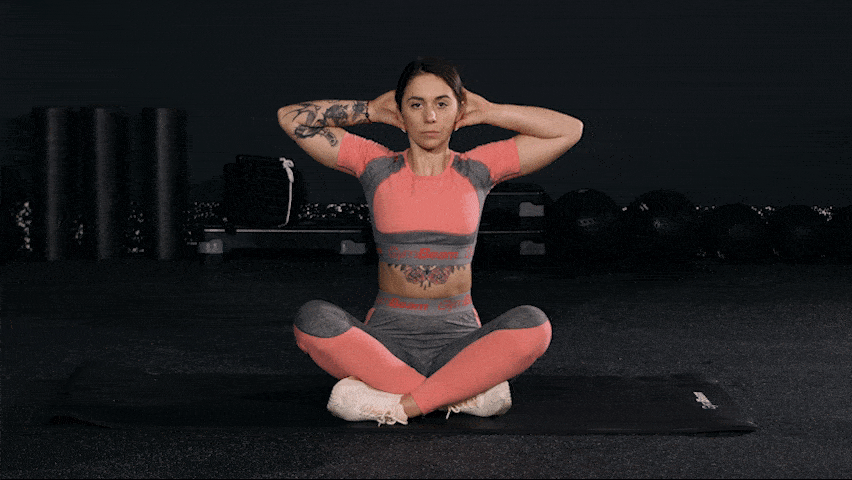
2. Clasping Neck Stretch
- Starting position: Sit cross-legged or so that you feel as comfortable as possible, extend your arms upwards and place your palms on the back of the head with intertwined fingers. The elbows point away from the body. Keep your back straight, your head in line with the spine and your shoulders back and down.
- Performance: Bend your head forward to the chest, pull the elbows together, and slightly round the upper back while exhaling. Breathe naturally and try to stay in this position for at least 15–30 seconds. You should feel the muscles around your cervical spine gradually relax. It will be reflected by bringing your head closer to your chest. Then return to the starting position and repeat the exercise 2–3 more times.
- Common mistakes: A small range of motion, uncontrolled movement, pressing the hands to the head excessively, too short hold.
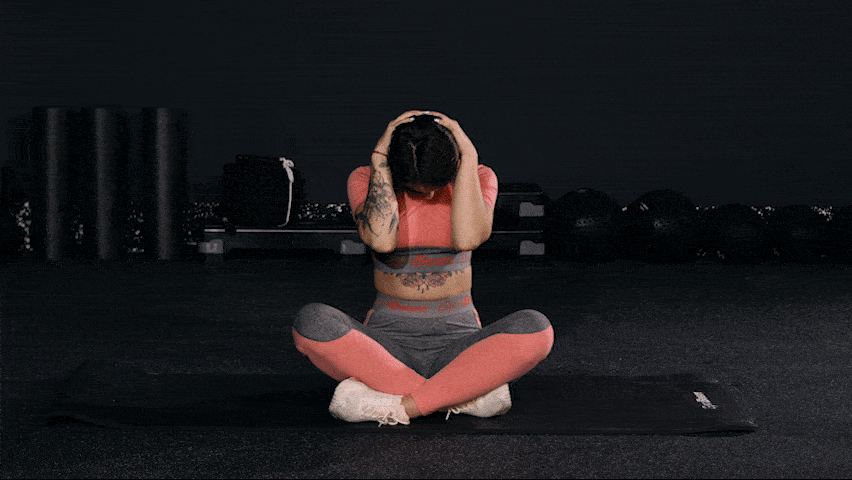
Neck Forward Semi Circles
- Starting position: Sit cross-legged or so that you feel as comfortable as possible. Place your arms freely on the knees. Keep your back straight, your head in line with the spine, and the shoulders back and down.
- Performance: First, tilt your head to one shoulder. Inhale and bend your head forward and make a semicircle to the other shoulder while exhaling. Then return to the first shoulder by doing a semicircle. Keep going until you have made at least 5 semicircles on each side.
- Common mistakes: A small range of motion, uncontrolled movements.
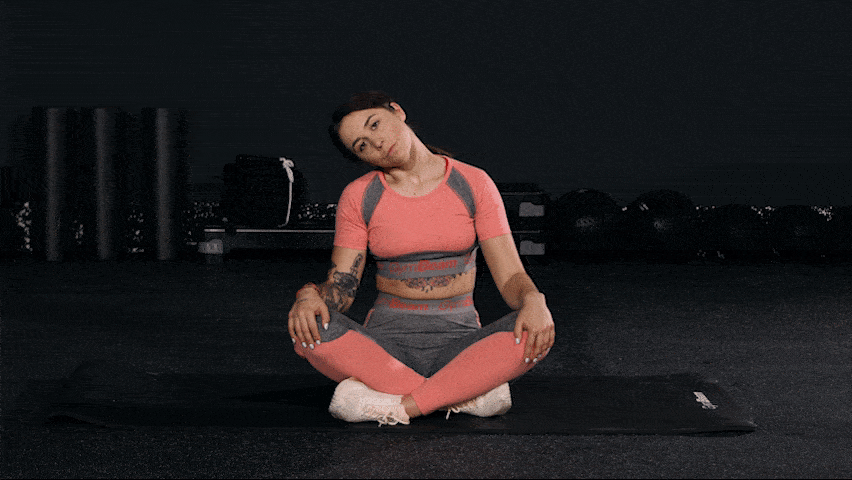
4. Neck Backward Semi Circles
- Starting position: Sit cross-legged or so that you feel as comfortable as possible. Place your arms freely on the knees. Keep your back straight, your head in line with the spine, and the shoulders back and down.
- Performance: First, tilt your head to one shoulder. Inhale and bend your head forward and make a semicircle to the other shoulder while exhaling. Then return to the first shoulder by doing a semicircle. Keep going until you have made at least 5 semicircles on each side.
- Common mistakes: A small range of motion, uncontrolled movements.
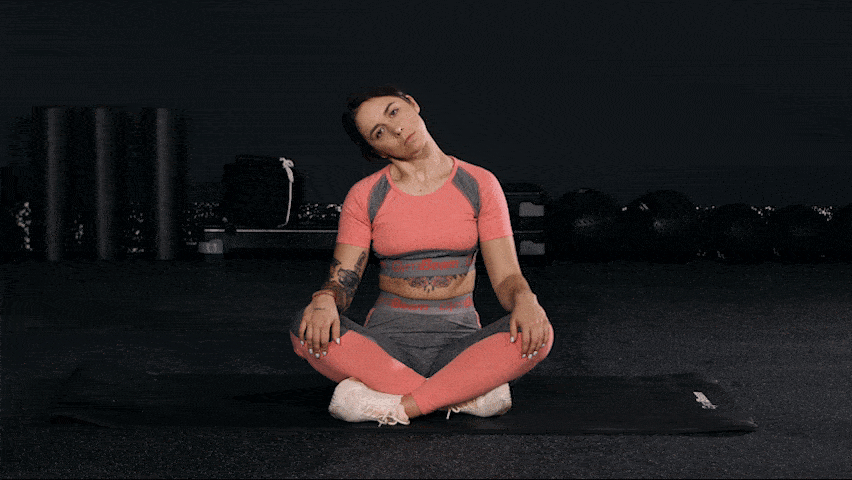
5. Neck Side Bend
- Starting position: Sit on the edge of a chair, box or mat. Place your right-hand palm over your left ear. Keep your back straight, your head in line with the spine and your shoulders back and down.
- Performance: Inhale and lean your head forward to your right shoulder. Breathe naturally and stay in this position for at least 15–30 seconds. Then change your hands and do the same on the other side. Then return to the starting position and repeat the exercise 2–3 more times.
- Common mistakes: A small range of motion, uncontrolled movement, the shoulders go up, pressing the hands to the head excessively.
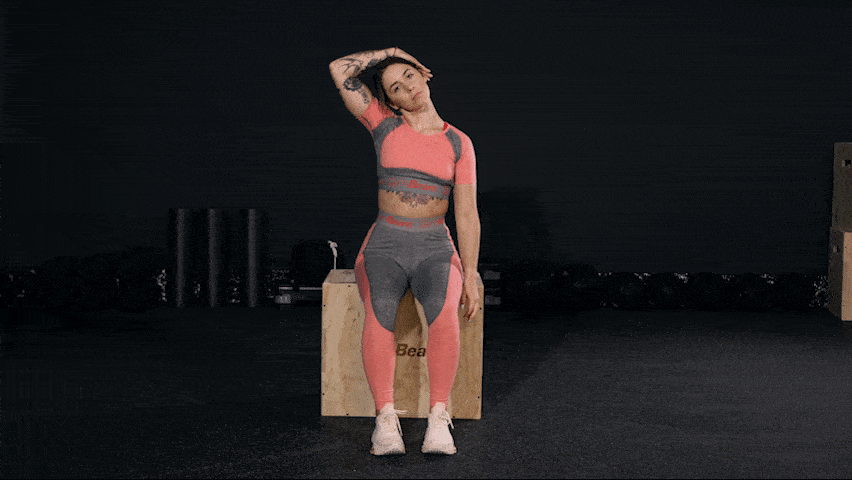
6. Lateral Neck Stretch
- Starting position: Sit on the edge of a chair, box or mat. Place your right-hand palm over your left ear. Keep your back straight, your head in line with the spine and your shoulders back and down.
- Performance: Lean your head to the right side towards the armpit. You can lightly push to the back of the head. Breathe naturally and try to stay in this position for 20–30 seconds. You should feel the increasing tension in the back part of the neck up to the shoulder. Then return the head to the starting position and repeat the exercise 2–3 more times. Then change sides and do the same exercise on the left side.
- Common mistakes: A small range of motion, uncontrolled movement, the shoulders go up, pressing the hands to the head excessively.

You might be interested in these products:
Simple exercises for the thoracic spine
You will especially appreciate the exercises below if you feel stiffness in your thoracic spine and are looking for a way to relax it. It will come in handy during the day, especially after a long sitting session or before a workout. The thoracic spine, to which the ribs are attached, affects the function of the shoulders and the spine stability. In motion, it is mainly involved in the torso rotation. With the help of selected exercises that will help you move and activate the whole chest, you will support good posture during the day and training. You will only need an exercise mat to stretch the muscles around the thoracic spine. [7]
1. Cat Cow Pose
- Starting position: Get down on all fours. Keep your wrists under your shoulders and the knees at about a shoulder-width distance or slightly wider.
- Performance: Bend your head forward towards the chest and round your back upwards. Tuck in your pelvis and belly. Raise your head and bend your back downwards while inhaling (the belly is closer to the mat). Then repeat this movement a couple of times.
- Common mistakes: A small range of motion, uncontrolled movements.
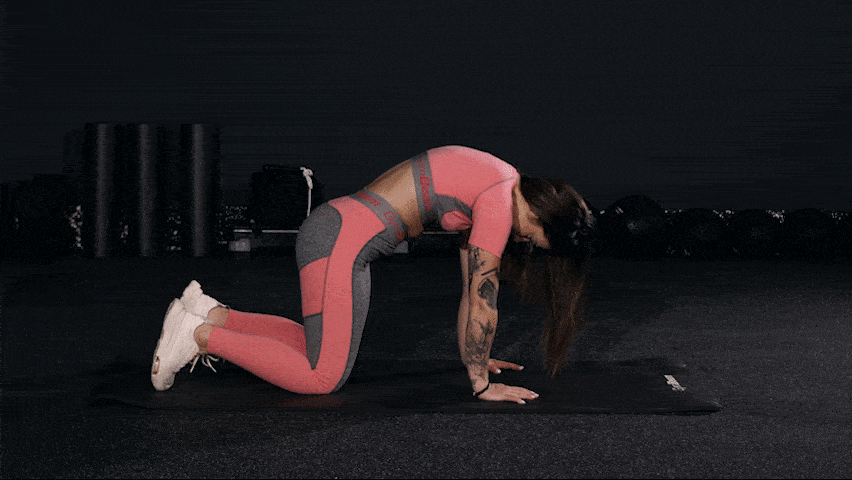
2. Kneeling T-Spine Rotation
- Starting position: Get down on all fours.
- Performance: Hold your with your right hand (behind the ear), and do the chest rotation to the right side while exhaling. Return to the starting position while inhaling and repeat the exercise a couple of times. Then switch hands and do the rotation to the other side.
- Common mistakes: Uncontrolled movement, a small range of motion, pressing the hand to the head excessively.

3. Thread the Needle
- Starting position: Get down on all fours.
- Performance: Raise your left arm towards the ceiling while inhaling and rotate your chest and head in the same direction. Then put your left arm through the gap under your right arm and rotate your torso in the same direction. At the same time, place your head on the mat (touching it with your ear). Your eyes should be facing the working arm. Also, remember to move your upper body only. Repeat the exercise a couple of times on one side, then switch your arms.
- Common mistakes: Uncontrolled movement, a small range of motion.
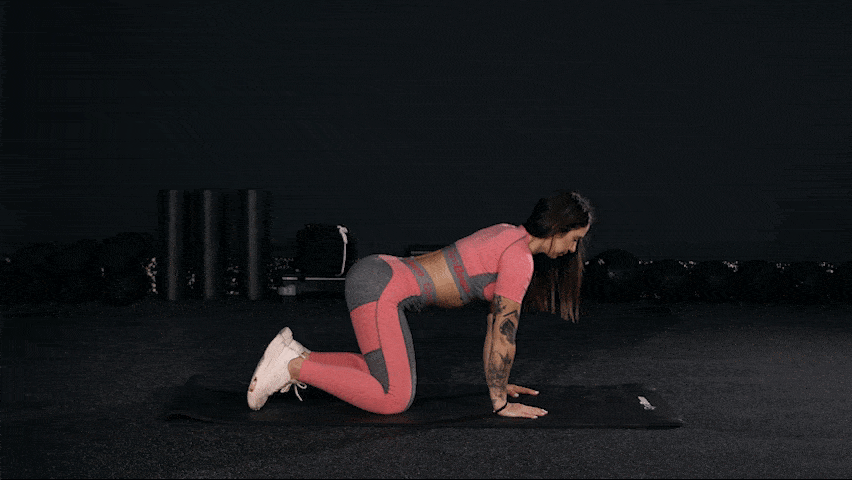
4. Bend-Over T-Spine Rotation
- Starting position: Shoulder-width stance (or slightly wider).
- Performance: Bend your knees and lean forward deeply with your back straight. At the same time, place your palms or fingers on the mat. Raise one arm towards the ceiling while inhaling, and turn your torso and head in the same direction. Your eyes are facing your working arm. Then return to the starting position while inhaling and rotate to the other side.
- Common mistakes: Uncontrolled movement, a small range of motion, bent back.
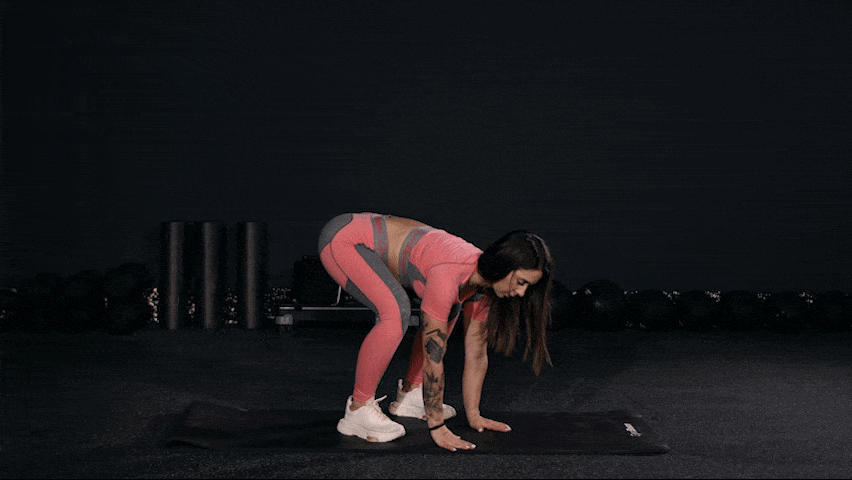
5. Downward Dog
- Starting position: Get down on all fours.
- Performance: Shift your weight to the upper limbs while inhaling, push the palms to the mat and raise your hips towards the ceiling. At the same time, extend your arms and legs. The knees can be slightly bent. The head remains in line with the spine, and the back is straight. Stay a few seconds in the upper position, breathe naturally. Then return to the starting position while exhaling. Then repeat the exercise a couple of times.
- Common mistakes: Small range of motion, uncontrolled movements, bent back.
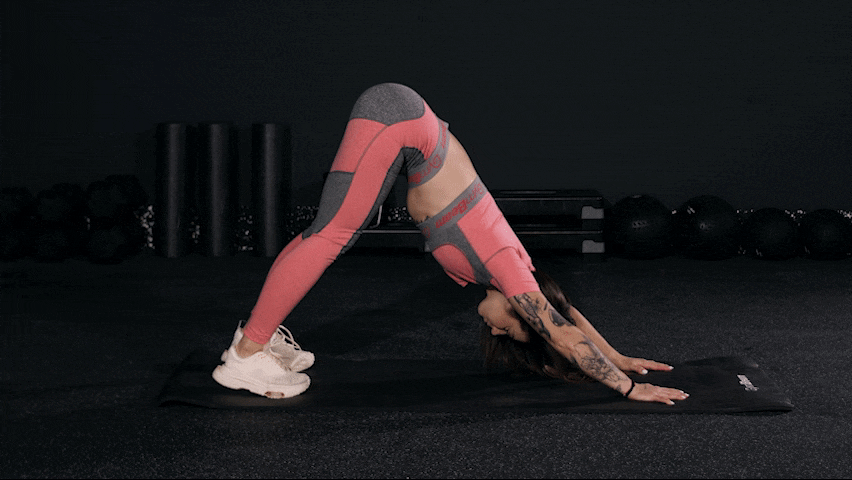
6. Puppy Pose
- Starting position: Get down on all fours. Keep your knees at a distance of about shoulder-width or slightly wider.
- Performance: Extend your arms in front of you and place your forehead on the mat. Keep your knees under your hips and tuck the belly in slightly. Stay in this position for a few minutes, breathe naturally and return to the starting position while exhaling. Then repeat the exercise a couple of times.
- Common mistakes: A small range of motion, bent elbows.
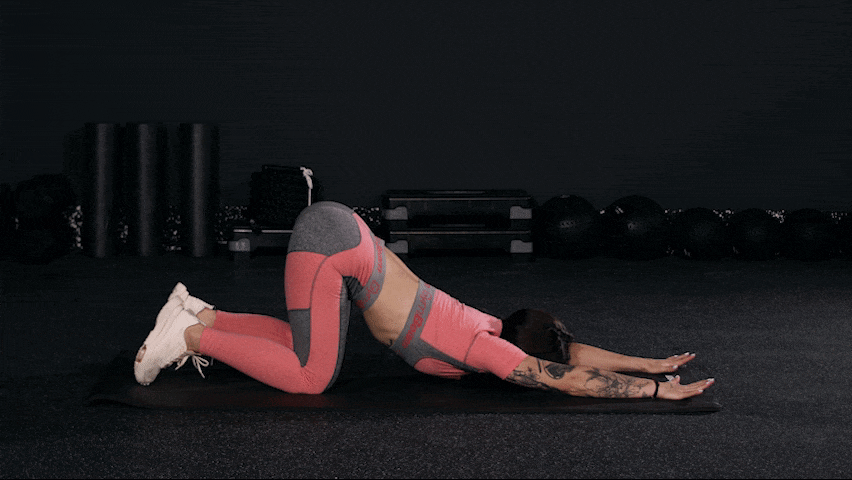
What should you remember?
Pain or stiffness in the cervical or thoracic spine can make the day and the training routine very uncomfortable. Fortunately, there is an effective solution – relaxation exercises. You can add them to your morning or evening stretching routine. However, they are also helpful as stretching before and after your workout. In addition, you can perform relaxing exercises for the cervical spine while sitting at work or learning. It will only take you a few minutes, which is definitely worth the relief.
If you want to do the maximum for your back, more information and tips on how to do it, read our article 7 Tips How to Outsmart Back Pain Caused by Long Periods of Sitting.
Was this article helpful to you? Be sure to send it to your friends, and help them relieve stiff neck or chest.
[1] Thoracic Back Pain | Symptoms, Causes and Treatment. – https://patient.info/bones-joints-muscles/back-and-spine-pain/thoracic-back-pain
[2] Nhs.Uk. Back pain. – https://www.nhs.uk/conditions/back-pain/
[3] Details, D. S. S. 4 Causes of Winter Back Pain (and What to Do About It. – https://www.towsonortho.com/4-causes-of-winter-back-pain-and-what-to-do-about-it/
[4] Page, P. CURRENT CONCEPTS IN MUSCLE STRETCHING FOR EXERCISE AND REHABILITATION. – https://www.ncbi.nlm.nih.gov/pmc/articles/PMC3273886/
[5] ACSM Certification Blog and Articles. – https://www.acsm.org/all-blog-posts/certification-blog
[6] Vaculíková, Šimberová, Svobodová. Základní gymnastika I. – https://www.fsps.muni.cz/frvs/2012/zakladni-gymnastika/protahovaci.html
[7] How Improving Thoracic (Mid Back) Spine Mobility Can Change Your Life. IMPACT Physical Therapy. – https://www.impactphysicaltherapy.com/how-improving-thoracic-spine-mobility-can-change-your-life/


Add a comment